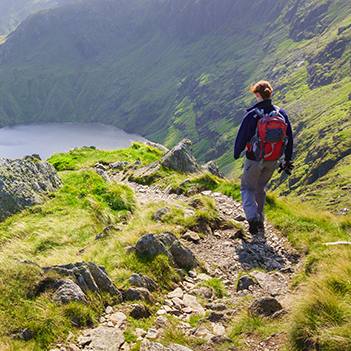Plodding through Spring
Wednesday April 3rd. Thirlmere Way part 1.
10 miles from Heaton Park. 11 walkers and 1 dog. Leader: Reg Kingston
Thirlmere Way.Section 1. Heaton Park Reservoir to Blackleach Country Park.
Some eleven Plodders and Maude gathered outside the Heaton Park Station on a cool but sunny morning. Reg handed out the guide to gate spotting researched and compiled by the ‘Nutters Mobile Surveillance Unit’. Apart from it’s humour the document lists the serious research the Nutters have undertaken relating to the Aqueduct.
Briskly walking into the park we reached the Hall and turned towards the Reservoir. The Reservoir is hidden from view by high banks and it is not possible to see where the Thirlmere Aqueduct enters. We saw two pipes which may have been connected with the Aqueduct but Water Engineers said that was not the case and said it enters near to where the Haweswater Aqueduct enters. By contrast the Haweswater Aqueduct is acknowledged by a mural on the Pumping House and below the mural are details of its construction, the engineers concerned and how much of the various materials were used. Alongside the Pumping House is a low wall which on climbing up allowed us to see the reservoir.
Continueing around the perimeter of the reservoir we walked back into the park and had our first break of the day close to the farm seeing en route some Highland cattle. Leaving the park by the Grand Lodge exit we briefly examined the impressive Collonade which was previously the front of Manchester Town Hall.
The Aqueduct travels beneath the roads leading from the park down to the bridge across the Irwell at Agecroft. To avoid walking along these busy roads we cut down Sedgley Park Road and after some urban walking reached the Prestwich Golf Course. Walking around the golf course and down Heathlands Drive we took a path leading into an modern housing estate. Emerging onto the A6044 we walked downhill to the bridge at Agecroft. This very ornate and impressive Victorian bridge gave us our first sight of two Aqueduct pipes.
From the bridge we continued along the road passing the entrance to the former Power Station at Agecroft. Further on we reached the former Manchester to Bury/Bolton canal. Walking down to the canal we obtained good views of the Aqueduct pipes as they cross the canal. Walking on a little further the pipes are again visible as they cross the Manchester to Bolton railway line. Continuing along the road we passed the site of the former Agecroft Colliery, now a retail park, forward under the railway bridge and up hill to the A666. It is interesting to note that over this last section how many steep climbs the Aqueduct takes and testifies to the power of the hydrostatic pressure as the result of the height difference between Lake Thirlmere and Heaton Park Reservoir (approximately 500 feet).
Crossing into Ranelagh Rd we examined the inspection hatch on the grass verge. Lifting the hatch and seeing the valves below we then had difficulty in closing the hatch! Passing what was Pendlebury Hospital, now a building site, we crossed to a footpath leading to Swinton Hall Road. The Aqueduct is below the A6 from this point,until it reaches Walkden,so we took a very urban cross country route to eventually reach Blackleach Country Park. At the far end of Swinton Hall Road some of us enjoyed a cuppa in Morrison’s cafe whilst others sat on the wall and enjoyed their lunch bathing in the sun.
Reaching the A6 again via Cromwell Road we saw the Aqueduct pipes crossing the railway at Moorside Station. Continuing along the A6 we passed beneath the Motorway bridges and eventually came to the bridge over a disused railway and further Aqueduct pipes, inspection hatches and what would have been sight of the first gate. Unfortunately some one has removed the iron gate leaving the stone posts. Reg had a photo of the gate and was able to show what it had looked like
Walking down the old railway track bed we reached Blackleach Country Park, its lake and eventually the Information Centre for 3.30pm. As arranged the Rangers let us us their lecture room to take a further tea break and discuss future events and dates. Reg estimated the distance to be around ten miles,but no doubt Martin will tell us more accurately what the distance was. Thanks once more to Martin’s generous gift of chocolate cake.The date of the next section, Blackleach to Adlington,is 1st May.
Reg
Please click on the link below for Martins blog and slideshow.
http://phreerunner.blogspot.co.uk/2013/04/wednesday-3-april-2013-thirlmere.html
Wednesday May 1st.
Thirlmere Way. Part 2 (Blackleach to Horwich) A Plodder Walk. 10 miles.
After a hectic 30 minutes putting together future Plodder Walks, enjoying the hospitality of the Blackleach Information Centre,12 Plodders fired with the urge to spot gates set off in bright sunlight. Within 10 minutes we were literally on top of the Aqueduct admiring the valve House which is situated on the recreation ground off Ridyard Street. The splendid building, protected from vandals by a fence, has the Manchester Corporation logo on one side and is identical to buildings seen near Kendal and one surprisingly in Stretford (?connected to water ringmain around Manchester.)
Moving on through a litter strewn council estate we found a rather sad gate with one stone pillar, a twisted but complete iron gate.Walking down Thirlmere road we reached the bridge over the former Eccles to Bolton (Great Moor Street) railway.Here for the first time were three pipes. Crossing to Seddon Street we saw more inspection hatches and then crossed an even more litter strewn council estate and industrial estate noting en route several stone gate posts but no iron gate. Eventually after crossing recreational fields,with unused football pitches, we reached our first complete gate.This gate has been cared for by the man living in the house next to the gate. In front of his garden are inspection hatches.The gentleman came out to talk with us. He has painted the gate black and has the key to the padlock which is a feature of many of the gates we will see. We were able to talk about our walk and how his is the first complete gate on our journey from Heaton Park.
Moving on to the A6 we had our first sight of the vast open cast mining site. Enormous slag heaps,referred to locally as the ‘Great Wall of China’ have been levelled and landscaped. Crossing a bridge over a former colliery railway Aqueduct pipes were seen. A mile further on we were able to turn off the A6 and passed two farms, Adises and Umbertons and find further complete gates, one almost completely hidden in the hedge. We enjoyed our first break overlooking the huge open cast site which is now being actively landscaped. Being a clear day we enjoyed views over towards the Welsh Hills.
Walking now through a private estate with it’s carefully kept gardens, no litter and quiet, we passed further inspection hatches and another hidden but complete(with padlock!) gate in the front garden of a local GP on the main road. Walking through another private and well kept estate we reached the A6 and walked along to find two more gates as the Aqueduct leaves the Hulton Estate.The Estate, recently sold to Peel Holdings was in the ownership of the Hulton Family for 1,000 years. It comprises over 1,000 acres of agricultural land and woodland. Everyone hopes it will remain a country estate.
Further along the A6, immediately before Chequerbent Island we studied the plaque telling us this was where the Leigh to Bolton railway crossed the A6, and was the first such level crossing in the world. The picture of what looks like Stephenson’s Rocket would fit with this railway, the first public railway in what was then Lancashire, being opened in 1828. Walking through an industrial estate which was previously the site of Chequerbent Station we crossed fields towards the M61 and next to a bridge over which the Leigh to Boltonrailway line crossed we had lunch. Through the bridge pass the three Aqueduct pipes. Both ends of the bridge are sealed off by gates and strong padlocks but there is enough space above the gates to see the pipes which here are at ground level.
Passing beneath the M61, and noting further gates and hatches en route we headed down Lock Lane and at Chew Gate passed four more complete gates. We headed for the railway via Wicken Lees Farm and the various free range chickens,hens,lambs,ducks etc. Allan kindly returned one lamb keen on following us. Via the Horwich Golf Course we headed towards the underground reservoir (Aqueduct originally intended to end here), passing further on a most impressive number of beautifully kept soccer,hockey,tennis and other pitches to reach the old chlorinating works and the end of the walk at Horwich Parkway.Walk ended at 3.30pm.
The next Plodder Walk,again Thirlmere Aqueduct Part 3, Horwich to Wheeldon, is on Wednesday 15th May. Further details of Plodder Walks 2013 to follow.
With regards the Thirlmere Aqueduct we felt it would be good to get north of the Ribble and into great Lancashire scenery, by the end of May, hence another walk planned for 29th May.(Wheeldon-River Ribble)
Reg
Thanks to Don for the pictures.
Thirlmere Way. Part 3.(Horwich to Wheelton) Weds May 15th
On a very wet morning some nine brave Plodders and Maude set forth. Chas bade us farewell with something along the lines that we should all be locked up!
Walking from our first gate near St Josephs School we rapidly walked along Chorley New Road to the boundry fence of the former Railway Works. Battling through large pools, litter and driving rain we reached the main road again and immediately in front of the Fire Station turned down to the entrance of the former railway works to view the inspection hatches.These are in line with the boundry fence, the Aqueduct running just inside the fence.
Norman, looking for a short cut through Thirlmere Gardens, improved his knowledge of where he now lives by realising there was no short cut!
Passing on via Mason Street and Leicester Avenue we came to the inspection hatches and gates situated in the island in the middle of the road.The hatches, in line with several others we were to see, have recently been strengthened and provided with security cameras. After debate we think this is to prevent terrorists from putting poison into the Aqueduct.
Walking through the playing fields towards Squirrel Lane we met a Water Board Diviner, equipped with his divining sticks, which in this case were metal ones. He had just located the pipes to the Aqueduct carrying water to Liverpool. He explained that he used metal ones because the pipes were plastic and the wooden sticks do not work. It is interesting that at this point the two Aqueducts are yards apart, one carrying water to Liverpool thirty miles away and the Thirlmere Aqueduct which starts ninety miles away.
Passing Anderton Manor Farm and into Lancashire and countryside we found five complete gates in quick succession and then needed Norman’s hedge cutting skills to cross a overgrown stile and onto the recently rerouted path leading into the backyard of the house opposite the Millstones Inn. We inspected the so called Headless Cross, which dates back to pre Norman Invasion times and was used as a way sign to Bolton, Blackburn and Preston.
Rapidly passing the Motorway and more hatches and gates in Shawes Lane we reached number 62,Sutton Lane and coffee/tea and biscuits provided by Saro. After this refreshment break the rain subsided and stopped. Passing more gates, we reached The Hall on the Hill,(Chorley Golf Club) and walking down the main drive could see enough of the West Pennine Moors to appreciate the view which is outstanding.Onwards past the former Fever Hospital Site, now a very up market estate, we reached the Yarrow. Walking along this very green and peaceful valley we reached the very impressive Aqueduct pipes as they cross the river. The four pipes and bridge work are a surprise in this otherwise rural spot.
Walking in the direction of Healey’s Nab we reached White House Farm with it’s views over Chorley, over to Parbold and it was clear enough to see Blackpool Tower. After further refreshments we headed downhill past two small reservoirs, an interesting small post box, further gates to head in the direction of Heapey. Crossing the former Blackburn to Chorley railway track bed we reached a further inspection hatch site with security cameras but a gate to allow access. Walking down to further hatches on the route of Norman’s Sunday charity walk and up to further gates and hatches we reached Wheelton at 4.15 pm and the bus back to Chorley/Adlington. The distance was recorded as 12 miles.
Reg
Thirlmere Way. Part 4. Wheelton to River Ribble. Weds May 29th







